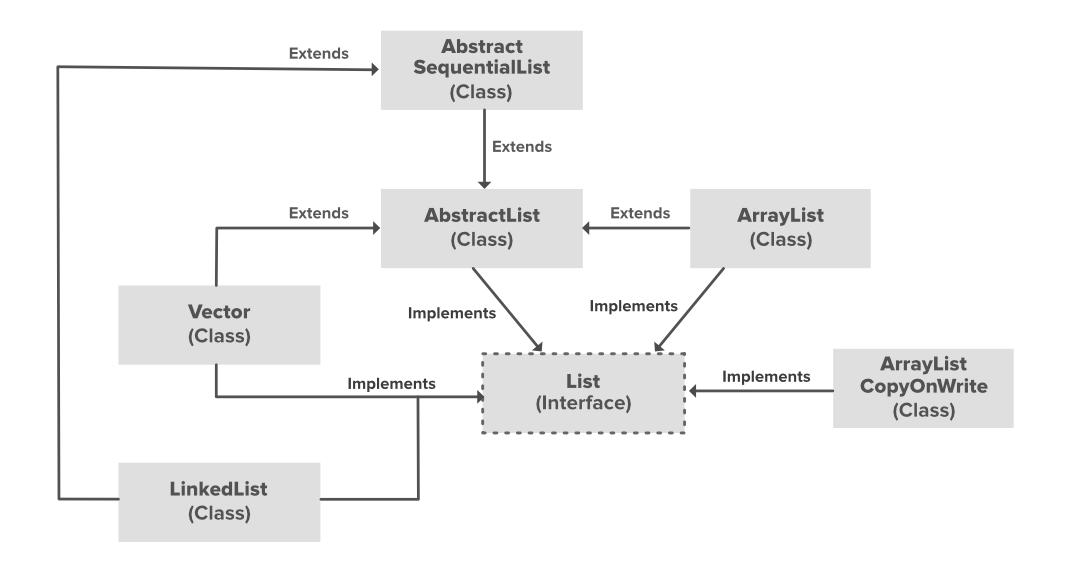【Java集合框架私密解析】:揭开性能与内存管理的神秘面纱
发布时间: 2024-09-11 09:29:34 阅读量: 146 订阅数: 36 


# 1. Java集合框架概览
## 理解Java集合框架的重要性
Java集合框架是Java编程语言中用于处理对象集合的一组接口和类。这些接口和类定义了多种用于存储、操作以及检索对象的方法。集合框架的重要性在于它提供了一套高效、可复用的数据结构以及对这些数据结构的统一访问方式。无论是在处理企业级应用,还是在日常的编程任务中,了解集合框架的使用和优化都是Java开发者的必备技能。
## 集合框架的核心接口
Java集合框架由多个接口和实现类构成,其核心接口主要包括:
- **List**:有序集合,允许存储重复元素。如`ArrayList`和`LinkedList`。
- **Set**:不允许存储重复元素的集合,主要用于进行集合运算。如`HashSet`和`TreeSet`。
- **Queue**:队列接口,用于实现先进先出(FIFO)的数据结构。如`LinkedList`、`PriorityQueue`。
- **Map**:存储键值对的映射表,不允许键重复。如`HashMap`和`TreeMap`。
## 集合框架的发展与版本兼容
自Java 1.2版本引入以来,Java集合框架经历了多次重要的更新和改进,以适应不同的应用场景。随着版本的更新,新的接口和实现类被添加,以满足开发者对性能、并发、内存管理等不同方面的需要。因此,理解各个版本中集合框架的变更,对于维护旧系统和开发新应用都至关重要。
总结而言,Java集合框架为开发者提供了一套丰富、灵活的数据处理工具,通过学习和掌握这些工具的特性及用法,可以极大提升开发效率与系统性能。在后续章节中,我们将深入探讨这些集合类的内部工作机制,以及它们在实际应用中的性能考量和优化策略。
# 2. 核心集合类的内部工作机制
集合框架是Java编程中不可或缺的一部分,它提供了一套性能优异、类型安全和易用的接口和实现,用于存储和操作对象集合。为了深入理解Java集合框架,我们必须探究其核心集合类的内部工作机制,其中包括List、Set和Map这三种基本的集合接口。本章中,我们将依次探讨这些集合的核心特点,如何实现其独特功能以及在不同应用场景下的性能比较。
## 2.1 List集合的性能特性
### 2.1.1 ArrayList与LinkedList的内部实现
`ArrayList`和`LinkedList`是List接口的两种主要实现,它们在数据存储和操作上具有根本的差异。
`ArrayList`基于动态数组数据结构,它允许快速的随机访问,因为数组中的元素是连续存储的。然而,这种实现方式在插入和删除操作时可能导致数据的移动,从而影响性能。
```java
// ArrayList 源码简要示例
public class ArrayList<E> extends AbstractList<E>
implements List<E>, RandomAccess, Cloneable, java.io.Serializable {
// 数组的初始容量
private static final int DEFAULT_CAPACITY = 10;
// 省略其他代码...
}
```
`LinkedList`则是基于双向链表实现的,它没有容量限制,允许在任意位置快速插入和删除元素。然而,由于其数据不连续,遍历操作不如数组高效。
```java
// LinkedList 源码简要示例
public class LinkedList<E> extends AbstractSequentialList<E>
implements List<E>, Deque<E>, Cloneable, java.io.Serializable {
// 链表头节点
transient Node<E> first;
// 链表尾节点
transient Node<E> last;
// 省略其他代码...
}
static class Node<E> {
E item;
Node<E> next;
Node<E> prev;
Node(Node<E> prev, E element, Node<E> next) {
this.item = element;
this.next = next;
this.prev = prev;
}
}
```
### 2.1.2 List的遍历与操作效率比较
遍历`ArrayList`的操作通常比`LinkedList`快,因为它使用的是连续内存空间,利用数组的索引可以实现O(1)的访问时间。而`LinkedList`由于其数据结构特性,需要遍历链表中的节点,因此每次访问元素都需要O(n)的时间复杂度。
在插入和删除操作方面,`LinkedList`通常表现更优。对于`ArrayList`,在列表中间插入或删除元素会导致数组元素的复制移动,而在`LinkedList`中,修改节点的前驱和后继指针即可完成操作。
具体操作时,我们还可以通过迭代器来遍历`List`:
```java
List<Integer> list = new ArrayList<>();
// 增加元素
for (int i = 0; i < 100; i++) {
list.add(i);
}
// 使用迭代器遍历ArrayList
Iterator<Integer> it = list.iterator();
while (it.hasNext()) {
Integer current = it.next();
// 对current进行操作
}
// 使用for-each循环遍历LinkedList
for (Integer value : list) {
// 对value进行操作
}
```
## 2.2 Set集合的唯一性保障机制
### 2.2.1 HashSet与TreeSet的工作原理
`HashSet`基于`HashMap`实现,内部通过哈希表来存储元素,保证了元素的唯一性。`HashSet`没有维护元素的顺序,检索元素的时间复杂度为O(1)。
```java
public class HashSet<E> extends AbstractSet<E> implements Set<E>, Cloneable, java.io.Serializable {
private transient HashMap<E,Object> map;
// 使用一个虚拟对象作为HashMap的值
private static final Object PRESENT = new Object();
public HashSet() {
map = new HashMap<>();
}
// 省略其他代码...
}
```
`TreeSet`则基于红黑树实现,它会根据元素的自然顺序或者构造时提供的`Comparator`来排序。元素的唯一性依赖于比较结果,而不是哈希码。`TreeSet`提供了一个在对数时间复杂度内对元素进行查找、插入和删除的有序集合。
```java
public class TreeSet<E> extends AbstractSet<E> implements NavigableSet<E>, Cloneable, java.io.Serializable {
private transient NavigableMap<E,Object> m;
// 省略其他代码...
}
```
### 2.2.2 红黑树与哈希表在Set中的应用
红黑树是一种自平衡的二叉查找树,每个节点都遵循红黑属性,这样可以保证最坏情况下树的高度维持在对数级别,因此`TreeSet`的查找、插入和删除操作的时间复杂度均为O(log n)。
哈希表(如`HashMap`)则通过计算键对象的哈希码来决定对象在表中的位置,通常情况下,哈希表提供了常数时间复杂度O(1)的平均查找性能,但这也依赖于哈希函数的质量和冲突解决策略。
在选择`HashSet`还是`TreeSet`时,需要根据是否需要元素有序以及期望的操作类型(如频繁的查找操作可能更适合`TreeSet`)来决定。
## 2.3 Map集合的键值对管理
### 2.3.1 HashMap与Hashtable的差异与性能分析
`HashMap`是Map接口的一个重要实现,它基于散列原理,允许使用null键和null值。由于其非线程安全的特性,`HashMap`的性能在大多数情况下都优于`Hashtable`。
```java
public class HashMap<K,V> extends AbstractMap<K,V>
implements Map<K,V>, Cloneable, Serializable {
transient Node<K,V>[] table;
// 省略其他代码...
}
```
`Hashtable`是较早的实现,它继承自`Dictionary`类,是线程安全的。然而,由于其同步机制,`Hashtable`在多线程环境下的性能通常会比`HashMap`差。
```java
public class Hashtable<K,V> extends Dictionary<K,V>
implements Map<K,V>, Cloneable, java.io.Serializable {
// 省略其他代码...
}
```
在并发环境中,`HashMap`可以通过`Collections.synchronizedMap`方法转换为线程安全的版本,或者使用`ConcurrentHashMap`来获取更好的性能。
### 2.3.2 TreeMap的排序原理与内存占用
`TreeMap`是基于红黑树的NavigableMap实现,因此它的键是有序的。当插入新的键值对时,`TreeMap`会根据键的自然顺序或提供的比较器来维护键的顺序。
```java
public class TreeMap<K,V> extends AbstractMap<K,V>
implements NavigableMap<K,V>, Cloneable, java.io.Serializable {
private final Comparator<? super K> comparator;
private transient Entry<K,V> root;
// 省略其他代码...
}
```
尽管`TreeMap`提供了有序的特性,但它的内存占用相对较高,因为它维护了一个完整的红黑树结构。在内存占用不是主要问题的情况下,`TreeMap`提供了一个非常有用的数据结构,特别是在需要数据有序并频繁进行插入、删除和查找操作的场景下。
以上章节内容是第二章的核心部分,接下来的部分将继续深入探讨每个集合类在特定应用场景下的性能差异和适用范围。
# 3. 集合框架的内存管理策略
## 3.1 集合对象的内存分配
### 3.1.1 Java垃圾回收机制概述
在Java虚拟机(JVM)中,垃圾回收(GC)是自动管理内存的一种机制。Java的垃圾回收器负责回收那些不再被任何活跃线程引用的对象所占据的内存空间。了解垃圾回收机制有助于我们更好地理解集合框架中的内存分配与回收。
垃圾回收过程通常涉及以下几个步骤:
1. **标记**:识别出所有活跃对象,即那些仍然被引用的对象。
2. **删除**:清除不再被引用的对象,回收它们的内存空间。
3. **压缩**(可选):将内存中的对象进行移动,以消除
0
0





